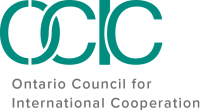
Together for Impact: What the Youth Policy-Makers Hub taught me about meaningful youth engagement
By Harshini Ramesh | 2020
At the start of the OCIC Youth Policy-Makers Hub (YPH) program, I was still green to the policy space. Having experienced barriers to entry, I wished to use the YPH as an opportunity to create avenues or provide support for others wishing to enter the policy world.
A common barrier to entry is the dearth of opportunities to gain relevant skill sets required to acquire policy opportunities. To address this barrier, I worked with fellow hub members to create the Youth Policy Advocates’ (YPA) Policy Corner organization, a chapter of Policy Corner based in Canada (also known as Turtle Island). The YPA Policy Corner organization is working towards providing youth with opportunities to publish policy ideas and build policy skills.
Creating an organization for youth, with the intention of catering to diverse needs and life experiences, demands that the wider youth community are intimately involved in the process of ideation and construction. We worked with youth to create this organization’s structure, strategic vision, and processes. Through this process, I learned the following lessons on meaningfully engaging with youth. While not comprehensive, these lessons are a starting point towards sustaining meaningful engagement.
Lesson 1: Recognize that all youth are different.
Youth are not a monolith; each individual comes with a unique intersectionality of identities and experiences. The barriers you experience will not mirror that of others. Recognizing personal limitations and biases can help identify gaps and open up opportunities to learn from others.
Lesson 2: Actively co-create with the youth community.
Co-creating requires listening to, involving, and actively engaging youth in projects to intentionally include and respond to diverse needs and asks. This empowers youth to have ownership over the project, act as leaders and advocate for the needs of their respective communities, as well as address their concerns and ensure their perspectives are valued.
Lesson 3: Respond to the community.
While creating the YPA Policy Corner, we actively involved different youth to participate at various points of the design process. Actions included inviting youth to design parts of our organization, consulting with youth, and responding to feedback in an effort to change our direction or rethink our intentions. We are still in our early stages and will continue to incorporate this practice as an ongoing commitment to evolving as our youth community identifies key needs or barriers.
Lesson 4: Create space for people to engage in their own capacity.
We fostered a space wherein youth could support at different points of the project, recognizing varying capacities for engagement. Creating space in projects to be flexible and offer continuous opportunities for engagement is necessary. It signals that everyone has the opportunity to meaningfully contribute, encouraging the representation of diverse voices.
Lesson 5: Share lessons from local action within national and global communities.
This organization is one chapter in a large network of global Policy Corner chapters. Through our work, we are actively sharing ideas from youth in Canada on a global stage. Actively seeking opportunities to amplify local work can facilitate knowledge sharing and spark change in other communities or jurisdictions. It also provides youth with the opportunity to have an impact and galvanize change on a grander scale.
Looking back on my participation in this year’s cohort, I am thankful for the space OCIC facilitated to encourage youth-led action and fostered for a community of diverse leaders who were keen on supporting their communities. I am privileged and honoured to have had this opportunity to engage with the incredible youth leaders in this hub and hope to create space for future leaders to leave their mark.






